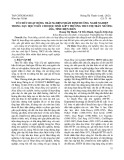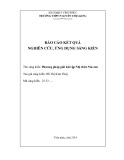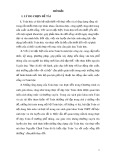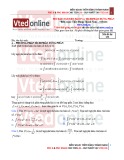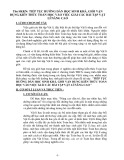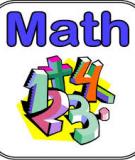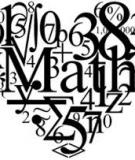Invariant and coinvariant spaces for the algebra of symmetric polynomials in non-commuting variables
Fran¸cois Bergeron∗ LaCIM Universit´e du Qu´ebec `a Montr´eal Montr´eal (Qu´ebec) H3C 3P8, CANADA
Aaron Lauve Department of Mathematics Texas A&M University College Station, TX 77843, USA
bergeron.francois@uqam.ca
lauve@math.tamu.edu
Submitted: Oct 2, 2009; Accepted: Nov 26, 2010; Published: Dec 10, 2010 Mathematics Subject Classification: 05E05
Abstract
We analyze the structure of the algebra KhxiSn of symmetric polynomials in non-commuting variables in so far as it relates to K[x]Sn, its commutative coun- terpart. Using the “place-action” of the symmetric group, we are able to realize the latter as the invariant polynomials inside the former. We discover a tensor product decomposition of KhxiSn analogous to the classical theorems of Chevalley, Shephard-Todd on finite reflection groups.
R´esum´e. Nous analysons la structure de l’alg`ebre KhxiSn des polynˆomes sym´e- triques en des variables non-commutatives pour obtenir des analogues des r´esultats classiques concernant la structure de l’anneau K[x]Sn des polynˆomes sym´etriques en des variables commutatives. Plus pr´ecis´ement, au moyen de “l’action par positions”, on r´ealise K[x]Sn comme sous-module de KhxiSn. On d´ecouvre alors une nouvelle d´ecomposition de KhxiSn comme produit tensorial, obtenant ainsi un analogues des th´eor`emes classiques de Chevalley et Shephard-Todd.
1 Introduction
∗F. Bergeron is supported by NSERC-Canada and FQRNT-Qu´ebec.
the electronic journal of combinatorics 17 (2010), #R166
1
One of the more striking results of invariant theory is certainly the following: if W is a finite group of n × n matrices (over some field K containing Q), then there is a W -module decomposition of the polynomial ring S = K[x], in variables x = {x1, x2, . . . , xn}, as a tensor product (1) S ≃ SW ⊗ SW
if and only if W is a group generated by (pseudo) reflections. As usual, S is afforded a natural W -module structure by considering it as the symmetric space on the defining vector space X ∗ for W , e.g., w · f (x) = f (x · w). It is customary to denote by SW the ring of W -invariant polynomials for this action. To finish parsing (1), recall that SW stands for the coinvariant space, i.e., the W -module
(2) SW := S/ SW +
(cid:10) (cid:11)
SW + defined as the quotient of S by the ideal generated by constant-term free W -invariant polynomials. We give S an N-grading by degree in the variables x. Since the W -action on S preserves degrees, both SW and SW inherit a grading from the one on S, and (1) is an isomorphism of graded W -modules. One of the motivations behind the quotient in (2) is to eliminate trivially redundant copies of irreducible W -modules inside S. Indeed, if V is such a module and f is any W -invariant polynomial with no constant term, then Vf is an isomorphic copy of V living within . Thus, the coinvariant space SW is the more interesting part of the story. (cid:10) (cid:11)
The context for the present paper is the algebra T = Khxi of noncommutative polyno- mials, with W -module structure on T obtained by considering it as the tensor space on the defining space X ∗ for W . In the special case when W is the symmetric group Sn, we elu- cidate a relationship between the space SW and the subalgebra T W of W -invariants in T . The subalgebra T W was first studied in [4, 20] with the aim of obtaining noncommutative analogs of classical results concerning symmetric function theory. Recent work in [2, 15] has extended a large part of the story surrounding (1) to this noncommutative context. In particular, there is an explicit Sn-module decomposition of the form T ≃ TSn ⊗ T Sn [2, Theorem 8.7]. See [7] for a survey of other results in noncommutative invariant theory. By contrast, our work proceeds in a somewhat complementary direction. We consider N = T Sn as a tower of Sd-modules under the “place-action” and realize SSn inside N as a subspace Λ of invariants for this action. This leads to a decomposition of N analogous to (1). More explicitly, our main result is as follows.
Theorem 1. There is an explicitly constructed subspace C of N so that C and the place- action invariants Λ exhibit a graded vector space isomorphism
N ≃ C ⊗ Λ. (3)
|x|
An analogous result holds in the case |x| = ∞. An immediate corollary in either case is the Hilbert series formula
(1 − ti). (4) Hilbt(C) = Hilbt(N)
d≥0
i=1 Y Here, the Hilbert series of a graded space V = defined as
Vd is the formal power series
d≥0 X
the electronic journal of combinatorics 17 (2010), #R166
2
L Hilbt(V) = dim Vd td,
|x|
where Vd is the homogeneous degree d component of V. The fact that (4) expands as a series in N[[t]] is not at all obvious, as one may check that the Hilbert series of N is
k=1 X
. (5) Hilbt(N) = 1 + tk (1 − t)(1 − 2 t) · · · (1 − k t)
1 ya2
In Sections 2 and 3, we recall the relevant structural features of S and T . Section 4 describes the place-action structure of T and the original motivation for our work. Our main results are proven in Sections 5 and 6. We underline that the harder part of our work lies in working out the case |x| < ∞. This is accomplished in Section 6. If we restrict ourselves to the case |x| = ∞, both N and Λ become Hopf algebras and our results are then consequences of a general theorem of Blattner, Cohen and Montgomery. As we will see in Section 5, stronger results hold in this simpler context. For example, (4) may be refined to a statement about “shape” enumeration.
2 The algebra SS of symmetric functions 2.1 Vector space structure of SS We specialize our introductory discussion to the group W = Sn of permutation matrices (writing |x| = n). The action on S = K[x] is simply the permutation action σ·xi = xσ(i) and SSn comprises the familiar symmetric polynomials. We suppress n in the notation and denote the subring of symmetric polynomials by SS. (Note that upon sending n to ∞, the elements of SS become formal series in K[[x]] of bounded degree; we call both finite and infinite versions “functions” in what follows to affect a uniform discussion.) A monomial in S of degree d may be written as follows: given an r-subset y = {y1, y2, . . . , yr} of x and a composition of d into r parts, a = (a1, a2, . . . , ar) (ai > 0), we write ya for ya1 2 · · · yar r . We assume that the variables yi are naturally ordered, so that whenever yi = xj and yi+1 = xk we have j < k. Reordering the entries of a composition a in decreasing order results in a partition λ(a) called the shape of a. Summing over monomials ya with the same shape leads to the monomial symmetric function
ya. mµ = mµ(x) :=
Xλ(a)=µ, y⊆x
Letting µ = (µ1, µ2, . . . , µr) run over all partitions of d = |µ| = µ1 + µ2 + · · · + µr gives a basis for SS d . As usual, we set m0 := 1 and agree that mµ = 0 if µ has too many parts (i.e., n < r).
2.2 Dimension enumeration A fundamental result in the invariant theory of Sn is that SS is generated by a family {fk}1≤k≤n of algebraically independent symmetric functions, having respective degrees
the electronic journal of combinatorics 17 (2010), #R166
3
n
deg fk = k. (One may choose {mk}1≤k≤n for such a family.) It follows that the Hilbert series of SS is
i=1 Y
(6) Hilbt(SS) = 1 1 − ti .
n
n
Recalling that the Hilbert series of S is (1 − t)−n, we see from (1) and (6) that the Hilbert series for the coinvariant space SS is the well-known t-analog of n!:
i=1 Y
i=1 Y
= (1 + t + · · · + ti−1). (7) 1 − ti 1 − t
In particular, contrary to the situation in (4), the series Hilbt(S)/Hilbt(SS) in Q[[t]] obvi- ously belongs to N[[t]].
2.3 Algebra and coalgebra structures of SS
Given partitions µ and ν, there is an explicit multiplication rule for computing the product mµ · mν. In lieu of giving the formula, see [2, §4.1], we simply give an example
(8) m21 · m11 = 3 m2111 + 2 m221 + 2 m311 + m32
and highlight two features relevant to the coming discussion.
k
k
First, we note that if n < 4, then the first term is equal to zero. However, if n is sufficiently large then analogs of this term always appear with positive integer co- If µ = (µ1, µ2, . . . , µr) and ν = (ν1, ν2, . . . , νs) with r ≤ s, then the par- efficients. tition indexing the left-most term in mµmν is denoted by µ ∪ ν and is given by sort- ing the list (µ1, . . . , µr, ν1, . . . , νs) in increasing order; the right-most term is indexed by µ + ν := (µ1 + ν1, . . . , µr + νr, νr+1, . . . , νs). Taking µ = 31 and ν = 221, we would have µ ∪ ν = 32211 and µ + ν = 531. Second, we point out that the leftmost term (indexed by µ ∪ ν) is indeed a leading term in the following sense. An important partial order on partitions takes
i=1 X
i=1 X
λ ≤ µ iff for all k. λi ≤ µi
d
d →
k ⊗ SS
d−k given, respectively, by
k=0 SS
With this ordering, µ ∪ ν is the least partition occuring with nonzero coefficient in the ν≥λ∪µ(SS)ν. Here product of mµmν. That is, SS is shape-filtered: (SS)λ · (SS)µ ⊆ (SS)λ denotes the subspace of SS indexed by partitions of shape λ (the linear span of L mλ), which we point out in preparation for the noncommutative analog. The ring SS is afforded a coalgebra structure with counit ε : SS → K and coproduct ∆ : SS
λ∪µ=ν X
L and ∆(mν) = mλ ⊗ mµ . ε(mµ) = δµ,0
the electronic journal of combinatorics 17 (2010), #R166
4
If |x| = ∞, ∆ and ε are algebra maps, making SS a graded connected Hopf algebra.
3 The algebra N of noncommutative symmetric func-
tions
3.1 Vector space structure of N Suppose now that x denotes a set of non-commuting variables. The algebra T = Khxi of noncommutative polynomials is graded by degree. A degree d noncommutative monomial z ∈ Td is simply a length d “word”:
z = z1z2 · · · zd, with each zi ∈ x.
In other terms, z is a function z : [d] → x, with [d] denoting the set {1, 2, . . . , d}. The permutation-action on x clearly extends to T , giving rise to the subspace N = T S of noncommutative S-invariants. With the aim of describing a linear basis for the homoge- neous component Nd, we next introduce set partitions of [d] and the type of a monomial z : [d] → x. Let A = {A1, A2, . . . , Ar} be a set of subsets of [d]. Say A is a set partition of [d], written A ⊢ [d], iff A1 ∪ A2 ∪ . . . ∪ Ar = [d], Ai 6= ∅ (∀i), and Ai ∩ Aj = ∅ (∀i 6= j). The type τ (z) of a degree d monomial z : [d] → x is the set partition
τ (z) := {z−1(x) : x ∈ x} \ {∅} of [d],
whose parts are the non-empty fibers of the function z. For instance,
τ (x1x8x1x5x8) = {{1, 3}, {2, 5}, {4}}.
Note that the type of a monomial is a set partition with at most n parts. In what follows, we lighten the heavy notation for set partitions, writing, e.g., the set partition {{1, 3}, {2, 5}, {4}} as 13.25.4. We also always order the parts in increasing order of their minimum elements. The shape λ(A) of a set partition A = {A1, A2, . . . , Ar} is the (integer) partition λ(|A1|, |A2|, . . . , |Ar|) obtained by sorting the part sizes of A in increasing order, and its length ℓ(A) is its number of parts (r). Observing that the permutation-action is type preserving, we are led to index the monomial linear basis for the space Nd by set partitions:
z mA = mA(x) :=
3, m12.3 = x1
2x2 + x2
3 + x2
1 + x2 For example, with n = 2, we have m1 = x1 + x2, m12 = x2 2, m1.2 = x1x2 + x2x1, 2x1, m13.2 = x1x2x1 + x2x1x2, m1.2.3 = 0, and so on. m123 = x1 (We set m∅ := 1, taking ∅ as the unique set partition of the empty set, and we agree that mA = 0 if A is a set partition with more than n parts.)
Xτ (z)=A, z∈x[d]
3.2 Dimension enumeration and shape grading Above, we determined that dim Nd is the number of set partitions of d into at most n parts. These are counted by the (length restricted) Bell numbers B (n) . Consequently,
d
the electronic journal of combinatorics 17 (2010), #R166
5
µ⊢d
(5) follows from the fact that its right-hand side is the ordinary generating function for length restricted Bell numbers. See [10, §2]. We next highlight a finer enumeration, where we grade N by shape rather than degree.
L For each partition µ, we may consider the subspace Nµ spanned by those mA for which λ(A) = µ. This results in a direct sum decomposition Nd = Nµ. A simple dimension description for Nd takes the form of a shape Hilbert series in the following manner. View commuting variables qi as marking parts of size i and set qµ := qµ1qµ2 · · · qµr . Then
µ⊢d X
(9) Hilbq(Nd) = dim Nµ qµ, = qλ(A).
XA⊢[d]
n
Here, qµ is a marker for set partitions of shape λ(A) = µ and the sum is over all partitions into at most n parts. Such a shape grading also makes sense for SS d . Summing over all d ≥ 0 and all µ, we get
i≥1 Y
µ X Using classical combinatorial arguments, one finds the enumerator polynomials Hilbq(Nd) are naturally collected in the exponential generating function
m
n
∞
∞
. (10) Hilbq(SS) = qµ = 1 1 − qi
m=0 X
k=1 X
d=0 X
. (11) = qk Hilbq(Nd) td d! 1 m! tk k!!
3,
See [1, Chap. 2.3], Example 13(a). For instance, with n = 3, we have
1 + 10 q2
3 + 60 q3q2q1 + 15 q2
Hilbq(N6) = q6 + 6 q5q1 + 15 q4q2 + 15 q4q2
d when we set all qk equal to 1.
thus dim N222 = 15 when n ≥ 3. Evidently, the q-polynomials Hilbq(Nd) specialize to the length restricted Bell numbers B (n) In view of (10), (11), and Theorem 1, we claim the following refinement of (4).
∞
Corollary 2. Sending n to ∞, the shape Hilbert series of the space C is given by
i≥1 Y
k=1 X
, (12) d! exp Hilbq(C) = 1 − qi qk
(cid:0) (cid:1)
d≥0 X with (–)|td standing for the operation of taking the coefficient of td.
tk k!!(cid:12) td (cid:12) (cid:12) (cid:12) (cid:12)
2
This refinement of (4) will follow immediately from the isomorphism C ⊗ Λ → N in Section 5, which is shape-preserving in an appropriate sense. Thus we have the expansion
2 + 3 q2q1
3
Hilbq(C) = 1 + 2 q2q1 + 3 q3q1 + 2 q2
2q1 + 4 q2q1
2 + 10 q2 (cid:1)
+ + · · · 4 q4q1 + 9 q3q2 + 6 q3q1 (cid:0)
the electronic journal of combinatorics 17 (2010), #R166
6
(cid:0) (cid:1)
P
3.3 Algebra and coalgebra structures of N Since the action of S on T is multiplicative, it is straightforward to see that N is a subalgebra of T . The multiplication rule in N, expressing a product mA · mB as a sum C mC, is easy to describe. Since we make heavy use of the rule later, of basis vectors we develop it carefully here. We begin with an example (digits corresponding to B = 1.2 appear in bold):
m13.2 · m1.2 = m13.2.4.5 + m134.2.5 + m135.2.4
(13) + m13.24.5 + m13.25.4 + m135.24 + m134.25
1 , A+k 2 , r }. Also, we set Abi := A \ {Ai}. Next, if X is a collection of set partitions of D,
Notice that the shapes indexing the first and last terms in (13) are the partitions λ(13.2)∪ λ(1.2) and λ(13.2) + λ(1.2). As was the case in SS, one of these shapes, namely λ(A) + λ(B), will always appear in the product, while appearance of the shape λ(A) ∪ λ(B) depends on the cardinality of x. Let us now describe the multiplication rule. Given any D ⊆ N and k ∈ N, we write D+k for the set D+k := {a + k : a ∈ D}.
By extension, for any set partition A = {A1, A2, . . . , Ar} we set A+k := {A+k . . . , A+k and A is a set disjoint from D, we extend X to partitions of A ∪ D by the rule
B∈X [ Finally, given partitions A = {A1, A2, . . . , Ar} of C and B = {B1, B2, . . . , Bs} of D (disjoint from C), their quasi-shuffles A ∪∪ B are the set partitions of C ∪ D recursively defined by the rules:
• A ∪∪ ∅ = ∅ ∪∪ A := A, where ∅ is the unique set partition of the empty set;
s
• A ∪∪ B :=
A ⋄ X := {A} ∪ B.
∪∪ (Bbi)
(A1 ∪ Bi) ⋄ , taking B0 to be the empty set. Ab1
i=0 [
(cid:16)
(cid:17) If A ⊢ [c] and B ⊢ [d], we abuse notation and write A ∪∪ B for A ∪∪ B+c. As shown in [2, Prop. 3.2], the multiplication rule for mA and mB in N is
C∈A ∪∪ B X
(14) mA · mB = mC .
The subalgebra N, like its commutative analog, is freely generated by certain monomial symmetric functions {mA}A∈A, where A is some carefully chosen collection of set parti- tions. This is the main theorem of Wolf [20]. We use two such collections later, our choice depending on whether or not |x| < ∞.
the electronic journal of combinatorics 17 (2010), #R166
7
The operation (–)+k has a left inverse called the standardization operator and de- It maps set partitions A of any cardinality d subset D ⊆ N to set noted by “(–)↓”.
partitions of [d], by defining A↓ as the pullback of A along the unique increasing bijection from [d] to D. For example, (18.4)↓ = 13.2 and (18.4.67)↓ = 15.2.34. The coproduct ∆ and counit ε on N are given, respectively, by
B ·∪C=A X
and ∆(mA) = ε(mA) = δA,∅, mB↓ ⊗ mC↓
where B ·∪C = A means that B and C form complementary subsets of A. In the case |x| = ∞, the maps ∆ and ε are algebra maps, making N a graded connected Hopf algebra.
4 The place-action of S on N
4.1 Swapping places in Td and Nd On top of the permutation-action of the symmetric group Sx on T , we also consider the “place-action” of Sd on the degree d homogeneous component Td. Observe that the permutation-action of σ ∈ Sx on a monomial z corresponds to the functional composition
z −→ x
σ −→ x
σ ◦ z : [d]
ρ
z
(notation as in Section 3.1). By contrast, the place-action of ρ ∈ Sd on z gives the monomial z ◦ ρ : [d] −→ [d] −→ x,
composing ρ on the right with z. In the linear extension of this action to all of Td, it is easily seen that Nd (even each Nµ) is an invariant subspace of Td. Indeed, for any set partition A = {A1, A2, . . . , Ar} ⊢ [d] and any ρ ∈ Sd, one has
(15) mA · ρ = mρ−1·A
(see [15, §2]), where as usual ρ−1 · A := {ρ−1(A1), ρ−1(A2), . . . , ρ−1(Ar)}.
4.2 The place-action structure of N
Notice that the action in (15) is shape-preserving and transitive on set partitions of a given shape (i.e., Nµ is an Sd-submodule of Nd for each µ ⊢ d). It follows that there is exactly one copy of the trivial Sd-module inside Nµ for each µ ⊢ d, that is, a basis for the place-action invariants in Nd is indexed by partitions. We choose as basis the functions
(16) mA, mµ := 1 (dim Nµ) µ! Xλ(A)=µ
with µ! = a1!a2! · · · whenever µ = 1a12a2 · · · . The rationale for choosing this normalizing coefficient will be revealed in (20).
the electronic journal of combinatorics 17 (2010), #R166
8
To simplify our discussion of the structure of N in this context, we will say that S acts on N rather than being fastidious about underlying in each situation that individual
Nd’s are being acted upon on the right by the corresponding group Sd. We denote the set NS of place-invariants by Λ in what follows. To summarize,
(17) Λ = span{mµ : µ a partition of d, d ∈ N} .
The pair (N, Λ) begins to look like the pair (S, SS) from the introduction. This was the observation that originally motivated our search for Theorem 1.
We next decompose N into irreducible place-action representations. Although this can be worked out for any value of n, the results are more elegant when we send n to infinity. Recall that the Frobenius characteristic of a Sd-module V is a symmetric function
µ⊢d X
Frob(V) = vµ sµ,
where sµ is a Schur function (the character of “the” irreducible Sd representation Vµ indexed by µ) and vµ is the multiplicity of Vµ in V. To reveal the Sd-module structure of Nµ, we use (15) and techniques from the theory of combinatorial species.
Proposition 3. For a partition µ = 1a12a2 · · · kak , having ai parts of size i, we have
th
(18) Frob(Nµ) = ha1[h1] ha2[h2] · · · hak [hk],
homogeneous symmetric with f [g] denoting plethysm of f and g, and hi denoting the i function.
Recall that the plethysm f [g] of two symmetric functions is obtained by linear and multiplicative extension of the rule pk[pℓ] := pk ℓ, where the pk’s denote the usual power sum symmetric functions (see [12, I.8] for notation and details).
Let Par denote the combinatorial species of set partitions. So Par[n] denotes the set partitions of [n] and permutations σ : [n] → [n] are transferred in a natural way to permutations Par[σ] : Par[n] → Par[n]. The number fix Par[σ] of fixed points of this permutation is the same as the character χPar[n](σ) of the Sn-representation given by Par[n]. Given a partition µ = 1a12a2 · · · kak , put zµ := 1a1a1!2a2a2! · · · kak ak!. (There are n!/zµ permutations in Sn of cycle type µ.) The cycle index series for Par is defined by
n≥0 X
µ⊢n X
, ZPar = fix Par[σµ] pµ zµ
1 pa2
2 · · · pak
k
(taking pi as the where σµ is any permutation with cycle type µ and pµ := pa1 i-th power sum symmetric function).
Proof. Recall that the Schur and power sum symmetric functions are related by
the electronic journal of combinatorics 17 (2010), #R166
9
, sλ = χλ(σµ) pµ zµ Xµ⊢|λ|
1 qa2
2 · · · qak
k
so ZPar = Frob(Par). Because Par is the composition E ◦ E+ of the species of sets and nonempty sets, we also know that its cycle index series is given by plethystic substitution: ZE◦E+ = ZE[ZE+]. See Theorem 2 and (12) in [1, I.4]. Combining these two results will give the proof.
First, we are only interested in that piece of Frob(Par) coming from set partitions of shape µ. For this we need weighted combinatorial species. If a set partition has shape µ, give it the weight qa1 in the cycle index series enumeration. The relevant identity is
j≥1 (cid:16)X
k≥1 X
exp − 1 ZP(q) = exp qk j 1 k pjk j (cid:18) (cid:19) (cid:17)
k
(cf. Example 13(c) of Chapter 2.3 in [1]). Collecting the terms of weight qµ gives Frob(Nµ). We get
i=1(cid:16)X λ⊢ai Y
ν⊢i (cid:17)(cid:2)X
. coeff qµ [ZPar(q)] = pλ zλ pν zν (cid:3) Standard identities [12, (2.14’) in I.2] between the hi’s and pj’s finish the proof.
As an example, we consider µ = 222 = 23. Since
, + and + + h2 = h3 = p2 1 2 p2 2 p3 1 6 p1p2 2 p3 3
a plethysm computation (and a change of basis) gives
3
+ + + + + h3[h2] = p3 1 6 p2 1 2 p2 2 p1p2 2 p2 1 2 p2 2 p3 3 p2 1 2 p2 2 (cid:21) (cid:21) (cid:21)
+ = + + + + + p2 2 1 6 (cid:20) p2 1 2 p2 2 (cid:20) p4 2 p2 2 2 1 2 1 3 p2 3 2 p6 2 (cid:18) (cid:19) (cid:19) (cid:18) (cid:18) (cid:19) (cid:18) (cid:19) (cid:20) p2 1 2 = s6 + s42 + s222.
That is, N222 decomposes into three irreducible components, with the trivial representa- tion s6 being the span of m222 inside Λ.
4.3 Λ meets SS
We begin by explaining the choice of normalizing coefficient in (16). Analyzing the abelianization map ab : T → S (the map making the variables x commute), Rosas and Sagan [15, Thm. 2.1] show that ab|N satisfies:
(19) ab(mA) = λ(A)!mλ(A) .
In particular, ab maps onto SS and
the electronic journal of combinatorics 17 (2010), #R166
10
(20) ab(mµ) = mµ .
Note that ab is also an algebra map. The reader may wish to use (19) to compare (8) and (13). Formula (20) suggests that a natural right-inverse to ab|N is given by
ι : SS ֒→ N, with and ι(1) = 1. (21) ι(mµ) := mµ
This fact, combined with the observation that ι(SS) = Λ, affords a quick proof of Theorem 1 when |x| = ∞. We explain this now.
5 The coinvariant space of N (Case:
|x| = ∞)
5.1 Quick proof of main result
π
When |x| = ∞, the pair of maps (ab, ι) have further properties: the former is a Hopf algebra map and the latter is a coalgebra map [2, Props. 4.3 & 4.5]. Together with (20) and (21), these properties make ι a coalgebra splitting of ab : N → SS → 0. A theorem of Blattner, Cohen, and Montgomery immediately gives our main result in this case.
Theorem 4 ([5], Thm. 4.14). If H −→ H → 0 is an exact sequence of Hopf algebras that is split as a coalgebra sequence, and the splitting map ι satisfies ι(¯1) = 1, then H is isomorphic to a crossed product A # H, where A is the left Hopf kernel of π. In particular, H ≃ A ⊗ H as vector spaces.
For the technical definition of crossed products, we refer the reader to [5, §4]. We mention only that: (i) the crossed product A # H is a certain algebra structure placed on the tensor product A ⊗ H; and (ii) the left Hopf kernel is the subalgebra
A := {h ∈ H : (id ⊗ π) ◦ ∆(h) = h ⊗ 1}.
We take H = N, H = SS, and π = ab. Since our ι is a coalgebra splitting, the coinvariant space C we seek seems to be the left Hopf kernel of ab. Before setting off to describe C more explicitly, we point out that the left Hopf kernel is graded: the maps ∆, id, and ab are graded, as is the map C # Λ ≃−→ N used in the proof of Theorem 4 (which is simply a ⊗ h 7→ a · ι(h)). Theorem 1 follows immediately from this result.
5.2 Atomic set partitions. Recall the main result of Wolf [20] that N is freely generated by some collection of func- tions. We announce our first choice for this collection now, following the terminology of [3]. Let Π denote the set of all set partitions (of [d], ∀ d ≥ 0). The atomic set partitions ˙Π are defined as follows. A set partition A = {A1, A2, . . . , Ar} of [d] is atomic if there does not exist a pair (s, c) (1 ≤ s < r, 1 ≤ c < d) such that {A1, A2, . . . , As} is a set partition of [c]. Conversely, A is not atomic if there are set partitions B of [d′] and C of [d′′] splitting A in two: A = B ∪ C+d′ . We write A = B|C in this situation. A maxi- mal splitting A = A′|A′′| · · · |A(t) of A is one where each A(i) is atomic. For example, the partition 17.235.4.68 is atomic, while 12.346.57.8 is not. The maximal splitting of
the electronic journal of combinatorics 17 (2010), #R166
11
the latter would be 12|124.35|1, but we abuse notation and write 12|346.57|8 to improve legibility.
It follows from [3, Corollary 9] that N is freely generated by the atomic monomial functions {mA : A ∈ ˙Π}. We now introduce an order on Π that will make this explicit. First we introduce the restricted growth function associated to a set partition (see Section 6.1): if A = {A1, A2, . . . , Ar} ⊢ [d], define w(A) ∈ Nd by
w(A) = w1w2 · · · wd,
(22) with wi := k ⇐⇒ i ∈ Ak.
• A ≻ B when c > d; or
• A ≻ B when c = d and w(A) >lex w(B).
For example, w(13.24) = 1212 and w(17.235.4.68) = 12232414. Now, given two atomic set partitions A ⊢ [c] and B ⊢ [d], we put:
Finally, given two set partitions A and B, put A > B if λ(A) 1|23|45|678 < 13.2|456|78 < 13.24|568.7 < 13.24|578.6 < 17.235.4.68 < 17.236.4.58 . In fact, 1|23|45|678 is the unique minimal element of Π of shape 3221. Define the leading term of a sum C αC mC to be the monomial mC0 such that C0
is greatest (according to > above) among all C with αC 6= 0. Combined with (14), our
definition of > makes it clear that the leading term of mA ·mB is mA|B and that N is freely
generated by the atomic monomial functions. Moreover, it is clear that multiplication in
N is shape-filtered. Since the left Hopf kernel C is a subalgebra, C is shape-filtered as
well. Finally, the isomorphism C # Λ ≃−→ N constructed in the proof of Theorem 4 is also
shape-filtered. These facts give Corollary 2 immediately. P . A ∈ ˙Π : ℓ(A) = 1 and A ∈ ˙Π : ℓ(A) > 1 ˙Π(1) := ˙Π(>1) := (cid:8) (cid:9) (cid:8) (cid:9) It is easy to find elements of the left Hopf kernel C. For instance, if A and B belong to
˙Π(1), then the Lie bracket [mA, mB] belongs to C. Indeed, ∆ ([mA, mB]) = ∆ mA|B − mB|A = mA|B ⊗ 1 + mA ⊗ mB + mB ⊗ mA + 1 ⊗ mA|B (cid:0) (cid:1) . ⊗ 1 + 1 ⊗ = − mB|A ⊗ 1 − mB ⊗ mA − mA ⊗ mB − 1 ⊗ mB|A
mA|B − mB|A mA|B − mB|A the electronic journal of combinatorics 17 (2010), #R166 12 (cid:1) (cid:0) (cid:1) (cid:0) Since ab(mA|B) = ab(mB|A), we have (id ⊗ ab) ◦ ∆ ([mA, mB]) = [mA, mB] ⊗ 1 as desired. Similarly, the difference of monomial functions m13.2 − m12.3 belongs to C.
The leading term here is indexed by 13.2 ∈ ˙Π(>1). These two simple examples essentially
exhaust the different ways in which an element can belong to C. The following discussion
makes this precise. From [3, Theorem 15], we learn that N is cofree cocommutative with minimal cogen-
erating set indexed by the Lyndon words in ˙Π. (This result and the previously mentioned
freeness result may also be deduced from the techniques developed in [9].) Since single let-
ters are Lyndon words, we know there are primitive elements associated to each atomic set
partition. Recall that an element h in a Hopf algebra is primitive if ∆(h) = h ⊗ 1 + 1 ⊗ h.
Let Prim(N) denote the set of primitive elements in N—a Lie algebra under the commu-
tator bracket. Bearing the free and cofree cocommutative results in mind, a classical theorem of
Milnor and Moore [13] guarantees that N is isomorphic to the universal enveloping algebra
U(L( ˙Π)) of the free Lie algebra L( ˙Π) on the set ˙Π. In the isomorphism L( ˙Π) ≃−→ Prim(N),
one may map A ∈ ˙Π(1) to mA since these monomial functions are already primitive. The
choice of where to send A ∈ ˙Π(>1) is the subject of the next proposition. Proposition 5. For each A ∈ ˙Π(>1), there is a primitive element ˜mA of N, B∈Π
X ˜mA = mA − αB mB, B αB = 1. satisfying: (i) if B ∈ ˙Π or λ(B) 6= λ(A), then αB = 0; and (ii) P µ Proof. Suppose A ∈ ˙Π(>1). A primitive ˜mA exists by the Milnor–Moore theorem, as
explained above.
(i). Since N = L (ii). Define linear maps ∆ j Nµ is a coalgebra grading by shape, we may assume λ(B) = λ(A)
for any nonzero coefficients αB. Now, since there are linearly independent primitive
elements in N associated to every atomic set partition, we may use Gaussian elimination
and our ordering on Π to ensure that αB = 0 for any B ∈ ˙Π.
+ : N+ → N ⊗ N recursively by ∆+(h)1 := ∆(h) − h ⊗ 1 − 1 ⊗ h, + (h) := (∆+ ⊗ id⊗j) ◦ ∆ j +(h) ∆ j+1 for j > 0. +(mA) = ∆ j
+( B αBmB) for all j > 1. Now, Assume that (i) is satisfied for ˜mA and that A = {A1, A2, . . . , Ar}. Since ∆+( ˜mA) = 0,
we have ∆ j ↓. ↓ ⊗ · · · ⊗ mAσr ↓ ⊗ mAσ2 σ∈Sr
X the electronic journal of combinatorics 17 (2010), #R166 13 ∆ r P
+(mA) = mAσ1 Indeed, the same holds for any B with λ(B) = λ(A): ↓. ↓ ⊗ · · · ⊗ mAσr ↓ ⊗ mAσ2 = αBmB αB ∆ r
+ mAσ1 B
(cid:16)X B
(cid:16)X σ∈Sr
(cid:17) X (cid:17) B αB = 1. Conclude that P We say an element h ∈ Nµ has the “zero-sum” property if it satisfies (ii) from the proposition. Put ˜mA := mA for A ∈ ˙Π(1). We next describe the coinvariant space C. L( ˙Π), L( ˙Π) ⊕ ˙Π(>1). (cid:3) (cid:2) Corollary 6. Let C be the Lie ideal in L( ˙Π) given by C =
If
ϕ : U(L( ˙Π)) → N is the Milnor–Moore isomorphism given by putting ϕ(A) := ˜mA for all
A ∈ ˙Π and extending multiplicatively, then the left Hopf kernel C is the Hopf subalgebra
ϕ(U(C)). L( ˙Π), L( ˙Π) (cid:2) (cid:3) Proof. We first show that ϕ(U(C)) ⊆ C. We certainly have ˜mA ∈ C for all A ∈ ˙Π(>1),
since the zero-sum property means ab( ˜mA) = 0. Next suppose f ∈
is a
sum of Lie brackets [A] = [[. . . [A′, A′′], . . .], A(t)]. In this case, ϕ(f ) ∈ C because each
ϕ([A]) is primitive and ab is an algebra map. Indeed, ab([ ˜mA′, ˜mA′′]) = 0. The inclusion
follows, since U(C) is generated by elements of these two types. It remains to show that C ⊆ ϕ(U(C)). To begin, note that L( ˙Π)/C is isomorphic to
the abelian Lie algebra generated by ˙Π(1). The universal enveloping algebra of this latter
object is evidently isomorphic to SS. (Send A = {[d]} to md.) The Poincar´e–Birkhoff–
Witt theorem guarantees that the map ϕ(U(C)) ⊗ SS → N given by a ⊗ b 7→ a · ι(b) is
onto N. Conclude that C ⊆ ϕ(U(C)), as needed. Before turning to the case |x| < ∞, we remark that we have left unanswered the
question of finding a systematic procedure (e.g., a closed formula in the spirit of M¨obius
inversion) that constructs a primitive element ˜mA for each A ∈ ˙Π(>1). This is accom-
plished in [11]. We repeat our example of Section 3.3 in the case n = 3. The leading term with respect
to our previous order would be m13.2.4.5, except that this term does not appear because
13.2.4.5 has more than n = 3 parts: m13.2 · m1.2 = 0 + m134.2.5 + m135.2.4 + m13.24.5 + m13.25.4 + m135.24 + m134.25 . Fortunately, the map w from set partitions to words on the alphabet N>0 reveals a more
useful leading term, underlined below: the electronic journal of combinatorics 17 (2010), #R166 14 (23) m121 · m12 = 0 + m12113 + m12131 + m12123 + m12132 + m12121 + m12112 . Notice that the words appearing on the right in (23) all begin by 121 and that the con-
catenation 121 12 is the lexicographically smallest word appearing there. This is generally
true and easy to see: if w(A) = u and w(B) = v, then uv is the lexicographically smallest
element of w(A ∪∪ B). w(µ) := 1µ12µ2 · · · kµk The map w maps set partitions to restricted growth functions, i.e., the words
w = w1w2 · · · wd satisfying w1 = 1 and wi ≤ 1 + max{w1, w2, . . . , wi−1} for all 2 ≤ i ≤ d.
We call them restricted growth words here. See [16, 17, 19] and [6, 8] for some of their
combinatorial properties and applications. These words are also known as “rhyme scheme
words” in the literature; see [14] and [18, A000110]. Before looking for a coinvariant space
C within N, we first fix the representatives of Λ. Consider the partition µ = 3221. Of
course, mµ is the sum of all set partitions of shape µ, but it will be nice to have a single one
in mind when we speak of mµ. A convenient choice turns out to be 123.45.67.8: if we use
the length plus lexicographic order on w(Π), then it is easy to see that w(123.45.67.8) =
11122334 is the minimal element of Π of shape 3221. We are led to introduce the words associated to partitions µ = (µ1, µ2, · · · , µk); we call such restricted growth words convex
words since µ1 ≥ µ2 ≥ · · · ≥ µk. We say that a restricted growth word is non-splittable if wi · · · wn−1wn is not a restricted
growth word for any i > 1. The maximal splitting of a restricted growth word w is
the maximal deconcatenation w = w′|w′′| · · · |w(r) of w into non-splittable words w(i). For
example, 12314 is non-splittable while 11232411 is a string of four non-splittable words
1|12324|1|1. It is easy to see that if a, b, c, and d are non-splittable, then ac = bd if and only if
a = b and c = d. Together with the remarks on A ∪∪ B following (23), this implies that if
{u1, u2, . . . , ur} and {v1, v2, . . . , vs} are two sets of non-splittable words, then and mu1mu2 · · · mur mv1mv2 · · · mvs share the same leading term (namely, mu1|u2|···|ur) if and only if r = s and ui = vi for all
i. In other words, our algebra N is non-splittable word–filtered and freely generated by
the monomial functions {mw (A) : w(A) is non-splittable}. This is one of the collections
of monomial functions originally chosen by Wolf [20]. the electronic journal of combinatorics 17 (2010), #R166 15 We aim to index C by the restricted growth words that don’t end in a convex word.
Toward that end, we introduce the notion of bimodal words. These are words with a
maximal (but possibly empty) convex prefix, followed by one non-splittable word. The
bimodal decomposition of a restricted growth word w is the expression of w as a
product w = w′|w′′| · · · |w(r)|w(r+1), where w′, w′′, . . . , w(r) are bimodal and w(r+1) is a
possibly empty convex word (which we call a tail). For a given word w, this decomposition
is accomplished by first splitting w into non-splittable words, then recombining, from left to right, consecutive non-splittable words to form bimodal words. For instance, the
maximal splitting of 1122212 into non-splittable words is 1|1222|12. The first two factors
combine to make one bimodal word; the last factor is a convex tail: 1122212 7→ 1 1222 12.
Similarly, 1231231411122311 7→ 123|12314|1|1|1223|1|1 7→ 123 12314 1 1 1223 1 1. Suppose now that u and v are restricted growth words and that the bimodal decom-
position of u is tail-free. Then by construction, the bimodal decomposition of uv is the
concatenation of the respective bimodal decompositions of u and v. We are ready to
identify C as a subalgebra of N. Theorem 7. Let C be the subalgebra of N generated by {mv : v is bimodal}. Then C has
a basis indexed by restricted growth words w whose bimodal decompositions are tail-free.
Moreover, the map ϕ : C ⊗ Λ → N given by mw′mw′′ · · · mw(r) ⊗ mµ 7→ mw′|w′′|···|w(r)|w(µ)
is a vector space isomorphism. Proof. The advertised map is certainly onto, since {mw : w ∈ w(Π)} is a basis for N
and every restricted growth word has a bimodal decomposition w′|w′′| · · · |w(r)|w(µ). It
remains to show that the map is one-to-one. Note that the monomial functions {mv : v is bimodal} are algebraically independent:
certainly, the leading term in a product mv1mv2 · · · mvs (with vi bimodal) is mv1|v2|···|vs;
now, since every word has a unique bimodal decomposition, no (nontrivial) linear combi-
nation of products of this form can be zero. Finally, the leading term in the simple tensor
mw′mw′′ · · · mw(r) ⊗ mµ is the basis vector mw′|w′′|···|w(r) ⊗ mw (µ), so no (nontrivial) linear
combination of these will vanish under the map ϕ. [1] Fran¸cois Bergeron, Gilbert Labelle, and Pierre Leroux. Combinatorial species and
tree-like structures, volume 67 of Encyclopedia of Mathematics and its Applications.
Cambridge University Press, Cambridge, 1998. Translated from the 1994 French
original by Margaret Readdy, With a foreword by Gian-Carlo Rota. [2] Nantel Bergeron, Christophe Reutenauer, Mercedes Rosas, and Mike Zabrocki. In-
variants and coinvariants of the symmetric groups in noncommuting variables. Canad.
J. Math., 60(2):266–296, 2008. [3] Nantel Bergeron and Mike Zabrocki. The Hopf algebras of symmetric functions
and quasi-symmetric functions in non-commutative variables are free and co-free. J.
Algebra Appl., 8(4):581–600, 2009. [4] George M. Bergman and Paul M. Cohn. Symmetric elements in free powers of rings. J. London Math. Soc. (2), 1:525–534, 1969. the electronic journal of combinatorics 17 (2010), #R166 16 [5] Robert J. Blattner, Miriam Cohen, and Susan Montgomery. Crossed products and
inner actions of Hopf algebras. Trans. Amer. Math. Soc., 298(2):671–711, 1986. [6] David Bremner and Lars Schewe. Edge-graph diameter bounds for convex polytopes with few facets. preprint, arXiv:0809.0915v2. [7] Edward Formanek. Noncommutative invariant theory. In Group actions on rings
(Brunswick, Maine, 1984), volume 43 of Contemp. Math., pages 87–119. Amer. Math.
Soc., Providence, RI, 1985. [8] Ira Gessel, Jonathan Weinstein, and Herbert S. Wilf. Lattice walks in Zd and per-
mutations with no long ascending subsequences. Electron. J. Combin., 5:Research
Paper 2, 11 pp. (electronic), 1998. [9] Florent Hivert, Jean-Christophe Novelli, and Jean-Yves Thibon. Commutative com- binatorial Hopf algebras. J. Algebraic Combin., 28(1):65–95, 2008. [10] Martin Klazar. Bell numbers, their relatives, and algebraic differential equations. J. Combin. Theory Ser. A, 102(1):63–87, 2003. [11] Aaron Lauve and Mitja Mastnak. The primitives and antipode in the Hopf algebra
of symmetric functions in noncommuting variables. preprint, arXiv:1006.0367v3. [12] Ian G. Macdonald. Symmetric functions and Hall polynomials. Oxford Mathemat-
ical Monographs. The Clarendon Press Oxford University Press, New York, second
edition, 1995. With contributions by A. Zelevinsky, Oxford Science Publications. [13] John W. Milnor and John C. Moore. On the structure of Hopf algebras. Ann. of Math. (2), 81:211–264, 1965. [14] John Riordan. A budget of rhyme scheme counts. In Second International Conference
on Combinatorial Mathematics (New York, 1978), volume 319 of Ann. New York
Acad. Sci., pages 455–465. New York Acad. Sci., New York, 1979. [15] Mercedes H. Rosas and Bruce E. Sagan. Symmetric functions in noncommuting variables. Trans. Amer. Math. Soc., 358(1):215–232 (electronic), 2006. [16] Bruce E. Sagan. Pattern avoidance in set partitions. Ars Combin., 94:79–96, 2010. [17] Rodica Simion. Combinatorial statistics on noncrossing partitions. J. Combin. The- ory Ser. A, 66(2):270–301, 1994. [18] Niel J. A. Sloane. The on-line encyclopedia of integer sequences. published electron- ically at http://www.research.att.com/∼njas/sequences/. [19] Michelle Wachs and Dennis White. p, q-Stirling numbers and set partition statistics. J. Combin. Theory Ser. A, 56(1):27–46, 1991. the electronic journal of combinatorics 17 (2010), #R166 17 [20] Margarete C. Wolf. Symmetric functions of non-commutative elements. Duke Math. J., 2(4):626–637, 1936.5.3 Explicit description of the Hopf algebra structure of C
We begin by partitioning ˙Π into two sets according to length,
6 The coinvariant space of N (Case:
|x| ≤ ∞)
6.1 Restricted growth functions
6.2 Proof of main theorem
References







